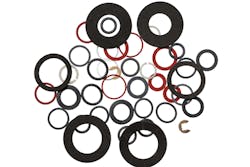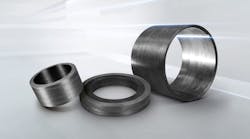When replacing and upgrading critical large-ticket items like pumps and process equipment for reliability and return on investment (ROI), do you consider related parts for the best quality?
Process reliability always stops at the weakest link. Upgrading your total investment will give you the process reliability and ROI. For example, a $1 O-ring cost an end user more than $50,000 to cover three-outage startups after the end user tried inferior O-rings multiple times before a quality one was finally installed.
A company could invest from $10,000 to $20,000 in an expensive premium pump, motor and stand, but then cut corners by only spending $250 on non-upgraded, basic related parts to go with the premium pumping system. Cutting this corner could be the beginning of failure (See Figure 1).
To help improve reliability and ROI, consider the following tips regarding parts and selecting the correct ones for the application. Reduce risk by not cutting corners.
Gaskets
It is not the gasket’s fault. Up to 70 percent of the time, gasket failure is caused by improper gasket selection, improper bolting hardware, improper installation and lack of maintenance after installation. Using a low-grade general service gasket further increases the chances of sealing issues. One of the biggest issues observed in pump casing gaskets is the majority are made of plain polytetrafluoroethylene (PTFE) material.
PTFE has a broad range of temperature and chemical capabilities, however basic PTFE has a cold flow issue that has been known for years. Some will say it is going into a groove and this does not matter, but several things can happen with basic PTFE material that causes issues. Tolerances on the groove and raised face can be great, allowing the basic PTFE material to extrude. The basic white PTFE can continue to flatten and extrude to the point it becomes translucent, causing bolt load loss. This also causes loss of the original shim tolerances required of the basic PTFE gasket to set the pump and impeller, increasing wear and lowering performance.
Consider a gasket that expands and contracts at the same rate as the metal in the pump during high- or low-temperature thermal cycling to prevent sealing loss. Also consider using higher sealability gaskets to prevent leaking acid or caustic in applications in which the liquid can damage the sealing surface, escalating the problem. In this case, the liquid erodes the pump, the base and concrete, creating a corrosive environment to all surrounding equipment.
Figure 1.
1. Two each — 6-inch 150# 1/8-inch ring type general service NA gasket: $5.81
2. ½-inch square graphite general service pump packing, six rings: $40.00
3. ½-inch lantern ring: $80.00
4. Pump casing gasket, 1/16-inch PTFE: $12.00
5. Impeller O-ring/gasket: $1.00
6. Four each — motor and bearing oil seals: $6.00
7. Rubber expansion joints: $100.00
Total: $244.81
Plain PTFE gaskets have been traditionally hand-cut or die-cut; neither are close tolerance and the width of the narrow flange is not consistent all the way around, meaning there is even less sealing surface on an already-narrow flange. Typical bolting uses small bolts in insufficient quantities to get the proper torque to affect a good seal. Using a computer numerical control (CNC) close tolerance gasket cutter and selecting a gasket material that helps hold the gasket seating stress will greatly improve the process reliability.
PTFE has different fillers now to help control cold flow. Metal gaskets with serrated or corrugated faces coated with PTFE or graphite work well if the groove is 3/8-inch wide or greater.
Sealing
General service pump packing requires leakage through the stuffing box to cool the low-grade fibers of the packing. These fibers are also abrasive and cause wear to the pump shaft. Newer style packing using higher-grade fibers and engineered packing sets are designed to run virtually leak-free. Also, these new packings will not score the shaft or build heat. The newer carbon and graphite packings are made with lubricated high-temperature fibers that can run as dry as mechanical seals with adjustment and have no catastrophic failure. These packings hold together and are easy to remove with traditional packing hooks for a complete inspection and repacking of the stuffing box.
Some of the engineered packing sets have adjustment features with closed, pressurized loops to keep the media out of the stuffing box and to reduce the amount of flush water used. Often the flush water that gets into the media dilutes it and has to be taken out through dewatering processes, evaporation or wastewater processing. This causes more energy use and environmental issues.
Beware of using very soft, easy-to-install/remove packing. Softer packing tends to extrude from the stuffing box (inside the pump) into the process and onto the ground much like spaghetti would. In this case, an end user might continue to just pull the packing gland and add more rings — which is never recommended. Softer packing can be used in combination with firmer end rings to help stop extrusion.
Lantern rings should still be used. With the newer pump packing fibers, these rings can be used as a pressure barrier controlled by the flush water and help keep contaminants out of the stuffing box. Many times the traditional PTFE lantern rings used to supply flush water to the packing are left out, increasing the wearing and heat on the packing and shaft/sleeve. Many times it is because these were traditionally machined-to-size and a replacement is not quickly available. Today, universal PTFE lantern ring sizes come in different widths and can be cut to the length needed that can be stocked for all pumps in the mill/plant.
Many pumps come with valves as part of the package and they use basic general application packing unless otherwise specified. As in the pump packing previously described, the new valve packings will offer better sealability and easier operation of the valves while reducing leaking and emissions. These new packing and engineered packing sets can easily meet or exceed emissions and leak detection and repair (LDAR) requirements.
If using an impeller gasket, follow the gasket recommendations above. If using an O-ring, be aware that O-rings have become a globally sourced commodity, meaning there are variations in material. Asking for a Buna, EPDM or FMK type O-ring may not result in the exact material needed. On severe chemical or critical service applications, consult with a gasket specialist about the proper verifiable rubber compound.
Sealing bearings
Sealing bearings may be the biggest overlooked tradition in the industry. Lip-type oil seals have been around a long time and are relatively inexpensive to purchase. The seal is made by the seal lip riding on the shaft. Some studies have shown new seals can lose their contact with the shaft due to wear within a few days. They also can trap abrasives and damage the pump shaft/sleeve. New bearing seal technology has existed for a while but is not as widely used. Newer style oil seals have some extreme long-life rubber and PTFE in the sealing element. But the shaft-wear issues remain in many applications. There are some lip-type cartridge designs that run on their own sleeve.
Bearing isolator type oil seals do not run on the shaft, which protects the shaft. They are built on the labyrinth principle, controlling the leak path with the oil level reaching mid-shaft. The basic ones drain the internal (good) oil back into the enclosed oil system, and drain the outside contaminants back to the outside. Some have an internal seal that increases the labyrinth sealing principle and keeps the rotating part from causing metal-to-metal contact. Specialty bearing isolators are also available for U.S. Food and Drug Administration (FDA) applications, flooded oil applications, vertical applications and very fine partial contamination applications.
One of the newest and forward-thinking specialty bearing isolators is a grounding seal for stray current from variable speed controller applications, static electricity and electrical environments.
A supervisor at a mill noticed a welding ground lead attached to the base of a 30-foot tall, all-metal stand, and welding repair was being done on top of the equipment. Because this machine wasn’t grounded at the welding area, at risk was hundreds of thousands of dollars in bearings in the stand. Further, the welding current was running through the equipment and where the bearing rollers made contact with the shaft. The current could arc, damaging the shaft and roller surface, which in turn also could cause early bearing failure, long downtimes and millions of dollars in lost production. A grounding seal would have been the best choice for this application.
Bearing isolators commonly come in bronze, stainless steel and PTFE. They come split for easy installation on the bearing or motor with no equipment breakdown required. They can replace basic LER-type labyrinth sealing rings in split bearings and the standard LER number can be used to interchange the proper bearing isolator.
Gasket, sealing and bearing damage
Many people do not design for, replace or use expansion joints. As the name implies, expansion joints handle expansion, compression and elongation of the pipeline as well as pipe misalignment. Pipe misalignment stress transfers directly to the pump structure and all moving parts. Some applications will have good piping alignment and have the piping anchored to stop expansion and contraction, or they will have short pipe runs so they do not use or need an expansion joint.
Expansion joints should also be considered "vibration-damping joints" because they have another important function for damping vibration. Any vibration created by the pump or other equipment is transferred through the pipelines. Any vibration created by the pump goes out the pump and down the connecting pipe until the first elbow, and then it returns right back to the pump. Rubber, PTFE and metal expansion joints dampen the vibration. Without the joint, the vibration goes straight to fixed or solid points on the pump.
Vibration causes metal fatiguing of the solid cast or machined flanges on the pump. It causes fractures on the pump mounting and even transfers to the bearing and mechanical parts of the pump. Even small, hardly detectable vibrations can have these effects.
There are many grades of expansion joints: handmade versus molded rubber; rubber-flanged versus metal-flanged rubber; PTFE-lined rubber versus PTFE bellows only; and many grades of rubber for many different services. Single-ply metal bellows have little-to-no vibration damping, while multi-ply metal joints can be custom-designed for specific movement capabilities and vibration damping. Expansion joints are made in metals of all grades.
Then there are so-called pump connector expansion joints. Be careful in this category. Many times a metal hose with an outer braid is used, but these have limited movement capabilities with little-to-no vibration damping effect. It is not an actual expansion joint. A true metal expansion joint will be a metal bellows body with no braid cover.
Putting it together
Take all of or even half of these non-upgrading issues addressed above, and multiply by the number of pumps, flanges, valves and sealing applications in the process and add in the continuing early repair cost. Scary, isn’t it?
Getting the best support parts to go with an expensive pumping system will allow you to get the best ROI. Engaging an experienced sealing specialist can help troubleshoot the issues and is recommended to maximize your process reliability and keep your pumping systems running smoothly.





